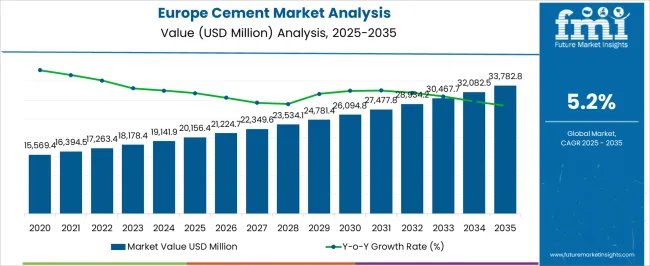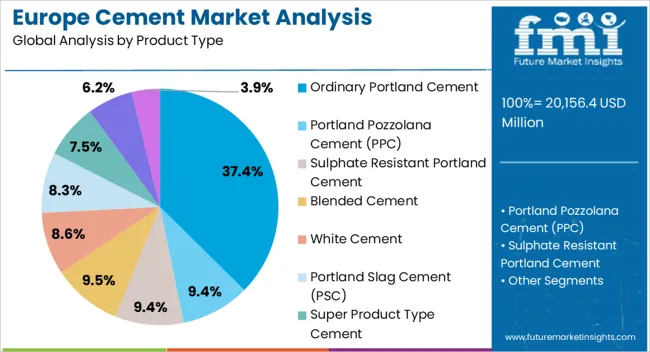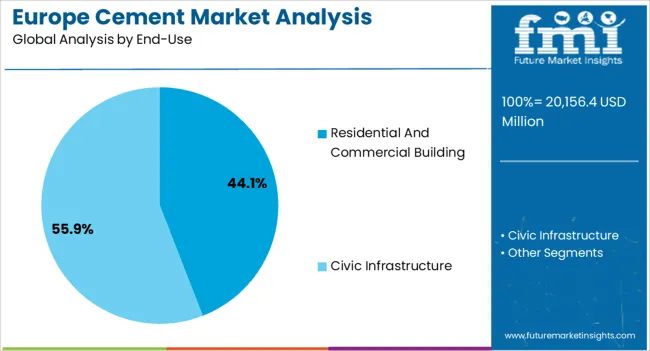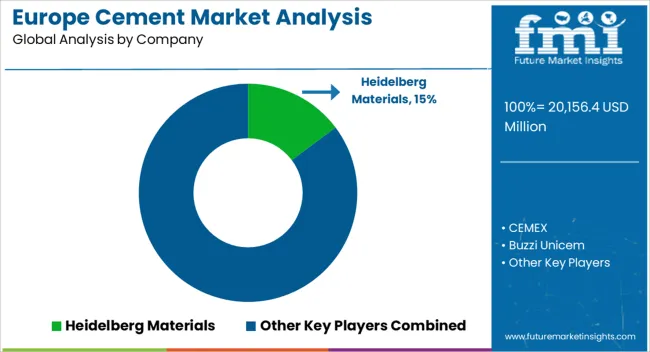The Europe Cement Market Analysis is estimated to be valued at USD 20156.4 million in 2025 and is projected to reach USD 33782.8 million by 2035, registering a compound annual growth rate (CAGR) of 5.2% over the forecast period.

| Metric | Value |
|---|---|
| Europe Cement Market Analysis Estimated Value in (2025 E) | USD 20156.4 million |
| Europe Cement Market Analysis Forecast Value in (2035 F) | USD 33782.8 million |
| Forecast CAGR (2025 to 2035) | 5.2% |
The Europe cement market is advancing steadily, supported by strong demand from residential and commercial construction, coupled with infrastructure modernization programs across the region. The industry is undergoing structural transformation with growing emphasis on sustainable production practices, alternative fuels, and reduced carbon emissions.
Market expansion is further reinforced by urban redevelopment initiatives, energy-efficient housing projects, and renovation activities in mature economies. The adoption of advanced manufacturing technologies is enhancing operational efficiency and improving product consistency, strengthening competitiveness among regional players.
Additionally, supportive regulations encouraging the use of low-clinker and blended cements are shaping future growth trajectories. With rising investments in green building projects and smart city developments, the Europe cement market is expected to sustain momentum, ensuring stable demand across both public and private sectors.

The ordinary portland cement segment leads the product type category, accounting for approximately 37.40% share. Its dominance is attributed to its broad applicability in structural construction and its long-standing position as the standard cement type across the region.
The segment benefits from consistent demand in residential, commercial, and infrastructure projects due to its strength, durability, and compatibility with various construction techniques. Although alternative cement types are gaining traction due to sustainability initiatives, ordinary portland cement continues to hold a strong position given its cost efficiency and established supply chain.
With renovation and new building projects maintaining robust activity levels across European countries, the ordinary portland cement segment is projected to retain its leadership in the medium term.

The residential and commercial building segment accounts for approximately 44.10% share of the end-use category in the Europe cement market. Growth in this segment is reinforced by rising housing demand, urban redevelopment, and sustained investments in office, retail, and mixed-use projects.
Cement usage in structural frameworks, foundations, and finishing applications supports consistent consumption levels. The segment also benefits from public initiatives aimed at improving housing affordability and promoting energy-efficient building practices.
Urbanization trends and the modernization of aging building stock further drive demand. With regulatory emphasis on sustainable construction and innovation in cement formulations, the residential and commercial building segment is expected to remain the largest consumer group within the European market.
Industry to Expand Over 1.7X through 2035
Europe’s cement industry is predicted to expand over 1.7X through 2035, amid a 3.2% increase in expected CAGR compared to the historical one. This is due to the rising demand for public infrastructure and non-residential buildings, such as hospitals and healthcare facilities.
The cement industry in Europe is projected to rise due to rapid population growth and increasing government initiatives for infrastructure development. By 2035, the industry is set to reach USD 31,742.5 million.
The United Kingdom is the Leading Cement Manufacturer
The United Kingdom is expected to retain its dominance in Europe’s cement industry during the forecast period. This is attributed to the following factors:
Europe cement industry grew at a CAGR of 2.1% between 2020 and 2025. The industry reached USD 18,178.4 million in 2025. In the forecast period, the cement industry in Europe is set to thrive at a CAGR of 5.3%.
| Historical CAGR (2020 to 2025) | 2.1% |
|---|---|
| Forecast CAGR (2025 to 2035) | 5.3% |
Europe’s cement industry witnessed moderate growth between 2020 and 2025. This was due to a rising awareness of environment-friendly infrastructure.
The acceleration of industrialization and urbanization was a result of the globalization movement and the expansion of developing economies. Consequently, this increased the need for cement as a basic building ingredient in Europe.
The general quality and safety of cement products were enhanced by the creation and implementation of quality standards & regulatory procedures. Growing consumer awareness of environmental issues has prompted the cement industry to prioritize sustainable methods.
It, in turn, has led to an emphasis on cement's dependability in building. The industry's growth trajectory has been determined by initiatives to lower carbon emissions, adopt energy-efficient technology, and investigate alternative raw materials.
Europe’s cement industry has seen a noticeable change toward more environmentally friendly methods in recent years. This involves utilizing more energy-efficient processes, switching to alternative fuels, and developing low & carbon-neutral cement to lessen carbon emissions.
Over the forecast period, the cement industry in Europe is poised to exhibit healthy growth, totaling a valuation of USD 31,742.5 million in 2035. This is due to a combination of several factors, including the rising use of cement in road construction, civil engineering, and others.
High demand for residential and commercial buildings due to population growth is expected to propel the growth of the cement industry in Europe. Investment in research and development is another crucial factor for the growth of the regional cement industry.
Key participants are investing in research & development to develop advanced and innovative products for sustainable development. They aim to develop advanced technologies to cater to the growing demand from end-use sectors.
Investments in research & development also benefits waste and hazardous waste management, which will help with sustainable development. The above factors, coupled with the increasing people's purchasing power, have led to the growing sales of cement for several applications in Europe.
The table below highlights key countries’ cement industry revenues in 2035. The United Kingdom, Germany, and France are expected to remain the top three consumers of cement in Europe, with expected valuations of USD 5,795.4 million, USD 5,177.3 million, and USD 4,481.8 million, respectively, in 2035.
| Countries | Cement Revenue (2035) |
|---|---|
| United Kingdom | USD 5,795.4 million |
| Germany | USD 5,177.3 million |
| France | USD 4,481.8 million |
| Italy | USD 2,811.5 million |
| Russia | USD 2,186.3 million |
The table below shows the estimated growth rates of the top five countries. France, the United Kingdom, and Germany are set to record high CAGRs of 6.2%, 5.8%, and 5.0% respectively, through 2035.
| Countries | Projected Value-CAGR (2025 to 2035) |
|---|---|
| France | 6.2% |
| United Kingdom | 5.8% |
| Italy | 4.3% |
| Germany | 5.0% |
| Russia | 4.4% |
The United Kingdom’s cement industry size is projected to reach USD 5,795.4 million in 2035. Over the assessment period, demand for cement in the United Kingdom is set to rise at a 5.8% CAGR.
The United Kingdom has exhibited an increasing understanding of the environmental impact of cement manufacturing in recent years. The country has been researching sustainable techniques and alternative materials to reduce carbon emissions related to cement making. Blended cement and other eco-friendly options are essential in pursuing more ecologically conscious construction methods.
Key enterprises substantially contribute to meeting the cement needs of the United Kingdom’s construction industry. The performance of the construction sector, driven by factors such as rising housing demand, infrastructure investments, and commercial projects, is influencing cement consumption in the United Kingdom.
The cement industry in Germany is an important part of the country's building industry. In Germany, cement consumption is tightly linked to economic conditions, infrastructure initiatives, and environmental concerns.
Germany is well-known for its modern construction sector and commitment to environmentally friendly building standards. The country has been at the forefront of implementing environmentally friendly technologies in construction, and this trend is continuing in the cement industry. Cement manufacturers in Germany are actively researching & implementing strategies to reduce carbon emissions and improve sustainability.
Heidelberg Cement, Dyckerhoff AG, and Schwenk are the key competitors in Germany’s cement industry. These firms make substantial contributions to meeting the cement demand in Germany. Cement sales in the country are projected to soar at a CAGR of 5.0% during the assessment period.
France has been emphasizing environmentally friendly policies and sustainable practices in the construction sector. Regulations aiming at lowering carbon emissions, encouraging the use of alternative fuels, and implementing more sustainable manufacturing techniques are expected to drive the country’s cement industry.
The degree of urbanization and continuing infrastructure-building initiatives are also the key drivers of cement consumption in France. The country’s government is investing in energy, transportation, and other infrastructure projects, which is driving the cement industry's expansion.
The competitiveness of cement producers in France is influenced by technological advancements in cement manufacturing. This includes the creation of more energy-efficient and environmentally efficient processes. The state of the residential housing sector has a direct impact on cement consumption in France.
Building and remodeling operations in the residential sector are further influenced by variables such as borrowing rates, housing affordability, and demographic shifts in France. Over the forecast period, cement demand in the country is set to increase at a robust CAGR of 6.2%.
The below section shows the ordinary Portland cement segment-leading in terms of product type. It is estimated to thrive at a 5.2% CAGR between 2025 and 2035. Based on end-use, the residential and commercial building segment is anticipated to hold a dominant share through 2035. It is set to exhibit a CAGR of 5.1% during the forecast period.
| Top Segment (Product Type) | Ordinary Portland Cement |
|---|---|
| Predicted CAGR (2025 to 2035) | 5.2% |
Ordinary Portland cement, also known as OPC, is the leading and dominating product type, followed by Portland pozzolana cement (PPC). OPC is the widely consumed cement in several end-use industries in Europe, such as marine and civic infrastructure.
It is also a widely manufactured cement, and because of its high compressive strength, this product is in high demand. Growing end-use industries are favoring OPC as it is suitable for common construction applications. As a result, these factors are likely to boost OPC demand throughout the forecast period.
| Top Segment (End-use) | Residential and Commercial Building |
|---|---|
| Projected CAGR (2025 to 2035) | 5.1% |
Based on the end-use, the residential and commercial buildings segment is expected to lead, followed by civic infrastructure. Growing demand for residential and commercial buildings due to the rapid population growth is expected to propel Europe’s cement industry.
Cement consumption in this end-user segment is high owing to the increasing urbanization and growing population, which necessitates accommodation. Drainage systems, stairs, roofs & walls, foundations, and others are all considered under this segment. As a result, this segment is expected to surge at a CAGR of 5.1% throughout the forecast period.

Europe’s cement industry is consolidated, with leading players accounting for 64.2% share. CEMEX, Buzzi Unicem, CRH PLC, Anhui Conch Cement Co. Ltd., Heidelberg Materials, Duna-Drava Cement, Holcim Ltd., Titan Cement Group, and Vicat Group are the leading manufacturers and suppliers of cement listed in the report.
In order to fulfill end-user demand, key cement firms in Europe are investing in research & development to produce new products and increase their manufacturing capacity. To expand their presence, leading players are directed toward implementing growth strategies such as collaborations, acquisitions, mergers, and facility expansions.
| Attribute | Details |
|---|---|
| Estimated Value (2025) | USD 20156.4 million |
| Projected Value (2035) | USD 33782.8 million |
| Anticipated Growth Rate (2025 to 2035) | 5.2% |
| Historical Data | 2020 to 2025 |
| Forecast Period | 2025 to 2035 |
| Quantitative Units | Value (USD million) and Volume (metric tons) |
| Report Coverage | Revenue Forecast, Volume Forecast, Company Ranking, Competitive Landscape, Growth Factors, Trends, and Pricing Analysis |
| Segments Covered | Product Type, End-use, Region |
| Key Countries Covered | Germany, Italy, France, United Kingdom, Spain, BENELUX, Russia, Rest of Europe |
| Key Companies Profiled | CEMEX; Buzzi Unicem; CRH PLC; Anhui Conch Cement Co. Ltd.; Heidelberg Materials; Duna-Drava Cement, Holcim Ltd.; Titan Cement Group, Vicat Group; UltraTech Cement Ltd.; Arabian Cement Company; EURO CEMENT, SECIL; OYAK Cement |
The global Europe cement market analysis is estimated to be valued at USD 20,156.4 million in 2025.
The market size for the Europe cement market analysis is projected to reach USD 33,782.8 million by 2035.
The Europe cement market analysis is expected to grow at a 5.2% CAGR between 2025 and 2035.
The key product types in Europe cement market analysis are ordinary portland cement, _opc 33, _opc 43, _opc 53, portland pozzolana cement (ppc), sulphate resistant portland cement, blended cement, white cement, portland slag cement (psc), super product type cement, hydrophobic portland cement and de-carbonated cement.
In terms of end-use, residential and commercial building segment to command 44.1% share in the Europe cement market analysis in 2025.






Full Research Suite comprises of:
Market outlook & trends analysis
Interviews & case studies
Strategic recommendations
Vendor profiles & capabilities analysis
5-year forecasts
8 regions and 60+ country-level data splits
Market segment data splits
12 months of continuous data updates
DELIVERED AS:
PDF EXCEL ONLINE
Europe Cement Packaging Market Analysis – Trends & Forecast 2024-2034
Europe Cruise Market Forecast and Outlook 2025 to 2035
Europe Massage Therapy Service Market Size and Share Forecast Outlook 2025 to 2035
European Union Tourism Industry Size and Share Forecast Outlook 2025 to 2035
Europe Injection Molding Machines Market Size and Share Forecast Outlook 2025 to 2035
Europe Injection Moulders Market Size and Share Forecast Outlook 2025 to 2035
Europe and MENA Generic Oncology Drug Market Size and Share Forecast Outlook 2025 to 2035
Europe Masking Tapes Market Size and Share Forecast Outlook 2025 to 2035
Europe Liners Market Size and Share Forecast Outlook 2025 to 2035
Europe Dermal Fillers Market Size and Share Forecast Outlook 2025 to 2035
Europe Trolley Bus Market Size and Share Forecast Outlook 2025 to 2035
Europe Protease Market Size and Share Forecast Outlook 2025 to 2035
Europe Luxury Packaging Market Size and Share Forecast Outlook 2025 to 2035
Europe & USA Consumer Electronics Packaging Market Size and Share Forecast Outlook 2025 to 2035
Europe Plant-Based Meal Kit Market Size and Share Forecast Outlook 2025 to 2035
Europe Temperature Controlled Packaging Solutions Market Size and Share Forecast Outlook 2025 to 2035
Europe Rubber Derived Unrefined Pyrolysis Oil Market Size and Share Forecast Outlook 2025 to 2035
Europe Pet Food Market Analysis by Nature, Product Type, Source, Pet Type, Packaging, Distribution Channel, and Country - Growth, Trends, and Forecast through 2025 to 2035
Europe's Golden Generation Travel Market Size and Share Forecast Outlook 2025 to 2035
Europe Automotive Night Vision System Market Size and Share Forecast Outlook 2025 to 2035

Thank you!
You will receive an email from our Business Development Manager. Please be sure to check your SPAM/JUNK folder too.
Chat With
MaRIA